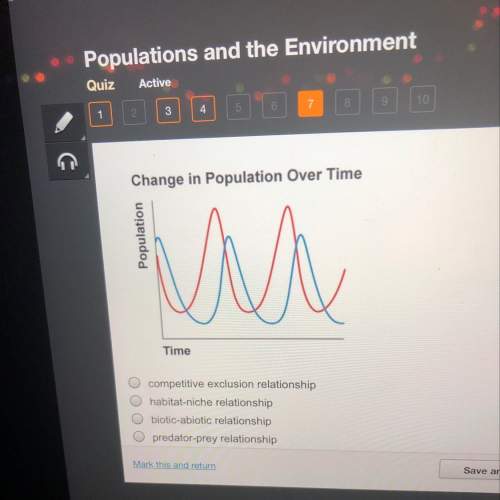
Biology, 23.11.2020 23:10 shaheedbrown06
An increase in consumption of resources may result in a scarcity of critical resources, including food, land, water, and fuel. This increase in resource use may also be accompanied by degradation of resources.
Review the graph below:
Line graphs showing the world ecological footprint by land type of carbon, fishing grounds, cropland, built up land, forest products, and grazing land measured in global hectares from 1961 to 2016. The graphs sections are layered on top of each other to show the cumulative amount. In 1961, the total was 7.05 billion global hectares, which increased to 20.5 billion global hectares in 2016. From 1961 to 2016, the increase in global hectares were 81 million to 473 million for built up land, 3.09 billion to 12.3 billion for carbon, 1.44 million to 3.98 million for cropland, 294 million to 670 million for fishing grounds, 1.32 billion to 2.04 billion for forest products, and 816 million to 1.05 billion in grazing lands.
© 2020 Global Footprint Network
A.
i. Explain the variables that make up the ecological footprint of an individual or country.
ii. Identify the component that is the largest contributor to the world's ecological footprint. Explain reasons for its current graphical trend.
B. The goal of sustainability is to stop and possibly undo some of the damage done to Earth's systems by using restorative processes and following a sustainable yield model when harvesting resources.
i. Describe an example of resource harvesting that uses a sustainable yield model.
ii. Propose one restorative process that reduces human impact on forest resources. Justify your proposed solution.


Answers: 3


Another question on Biology

Biology, 22.06.2019 10:00
Cladistics is a way of classifying organisms by examining the characteristics of their ancestors and descendants and depicting the relationships in a cladogram. which of the following best describes a challenge in classifying organisms this way? a. there are millions of species on earth, and a cladogram is not a practical means for classifying all of them. b. it is impossible to tell which organisms are most closely related to each other using a cladogram. c. cladograms are detail-oriented and do not provide a useful understanding of evolutionary relationships. d. there is a limited number of ways to organize the information, so most cladograms end up looking very similar.
Answers: 2

Biology, 22.06.2019 19:00
Mercury metal is poured into a graduated cylinder that holds exactly 22.5 ml the mercury used to fill the cylinder mass in 306.0 g from this information calculate the density of mercury
Answers: 2

Biology, 22.06.2019 23:00
What determines whether a particular cell is able to respond to a hormone?
Answers: 3

Biology, 23.06.2019 00:00
The footprint of a dinosaur and the burrow of an ancient shrimp are examples of which kind of fossils a.body b.amber c.trace d.index
Answers: 3
You know the right answer?
An increase in consumption of resources may result in a scarcity of critical resources, including fo...
Questions

Mathematics, 17.07.2019 22:00

Geography, 17.07.2019 22:00

Biology, 17.07.2019 22:00

Geography, 17.07.2019 22:00


Mathematics, 17.07.2019 22:00









History, 17.07.2019 22:00


Social Studies, 17.07.2019 22:00


Mathematics, 17.07.2019 22:00




